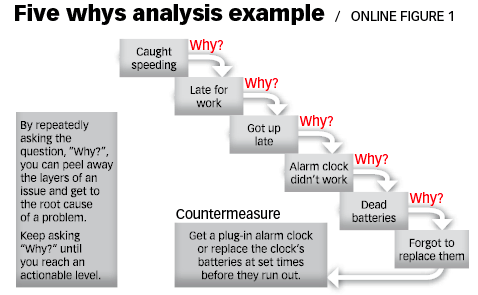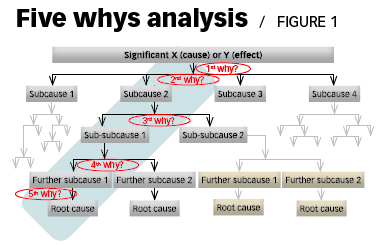One of the most common ways to drill down from a problem to the root cause(s) of that problem is the “5 whys” approach.
I wrote before that Chinese manufacturing engineers & managers are, on average, very bad at uncovering root causes… which is why they typically fail to address root causes, and in the end they see the same issues come back again and again.
Vidyasagar A wrote a good article in Quality Progress (January 2015) entitled The Art of Root Cause Analysis.
It starts by showing an example of a 5-why analysis. the problem is “getting caught speeding on the road.”
This particular example captures just one answer for every why question asked. Typically, you would have more than one answer for every why question, and each one could be subjected to another why question.

The ‘5 whys’ approach is really an art. There are several sub-causes, sub-sub-causes, and so on.

Here are a few frequently-asked questions.
Is 5 a magic number? No. 2 ‘whys’ might be enough, or 8 ‘whys’ might be necessary.
How to be sure you can stop going down to the next sub-cause?
Some experienced practitioners say that you have reached the true root cause when the answer to your why question is a process, policy or a person. Often, these answers turn out to be the real root causes.
Can’t a human mistake be a root cause? No. It is quite tempting to stop there and blame someone. But it is not called the “5 whos” analysis. Saying “it is the operator’s fault because they didn’t pay attention” might be true, but it is never a root cause. The next question is, “Why didn’t they pay attention?”
Once we find a root cause, can we just address it and then the problem will never come back? Unfortunately it’s not that easy. There might be other root causes, so you should identify all the major ones. The problem might appear due to a complex inter-relationship between several variables (that’s where statistical analysis comes into play). And of course, the countermeasures you put in place have to stay in place for as long as they make sense!
In other words, you need to know your processes and understand the cause-and-effect relationships that decide the outputs of your processes.
